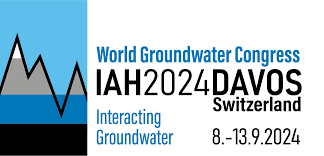Dear colleagues and friends of the Transboundary Aquifers Commission,
We have the pleasure to invite you to the upcoming IAH Congress in Davos, Switzerland, 8-13 September 2024. We have organized the session: On effective transboundary groundwater areas for shared aquifer management
Our session will discuss existing challenges, approaches, and best practices in prioritising assessment areas to support transboundary aquifers' sustainable management and governance and help guide policy and decision-making. It will include a series of keynote presentations and a panel discussion. Posters are also invited.
You will find a detailed description and more information in the file attached to this message
The deadline for abstracts submission is February 29, 2024.
We hope to hear from you and to meet with you in Davos.
Best regards
Alfonso Rivera, Ph.D.
----------------------------------
Chairman of the IAH Transboundary Aquifers Commission

CALL FOR ABSTRACTS, deadline: 29 Feb. 2024
IAH ANNUAL CONGRESS, DAVOS, Switzerland,
http://www.iah2024davos.org/parallel
You are cordially invited to submit an abstract for the session: On effective transboundary groundwater areas for shared aquifer management
Co-hosted by: IAH-Transboundary Aquifers Commission, International Groundwater Resources Centre (IGRAC), Permanent Forum of Binational Waters, SADC-Groundwater Management Institute (GMI), UNESCO, Centre for Sustainable Solutions in Applied Hydrogeology
When dealing with a shared aquifer where groundwater crosses from one jurisdiction to another, we often face difficult decisions about how to proceed with the scale of the transboundary aquifer assessment. We must decide whether the assessments should be based on the entire aquifer extent (often the most expensive approach), or on a particular aquifer zone, hotspots, transboundary corridors, groundwater flow systems, groundwater residence time, radius of influence, or capture areas. To do that correctly, however, groundwater dynamics within the aquifer (time and space scales) must be well understood closer to the jurisdictional boundary.
Further, to complement the knowledge of groundwater dynamics, new elements and/or variables need to be added, e.g., social, economic, and political needs. Although a full aquifer-wide transboundary assessment may be essential, often transboundary impacts are limited to border regions, or zones with troubling spots. Here, it might be useful to focus on a more detailed assessment at smaller scales to alleviate data scarcity, financing and capacity issues. However, a significant challenge exists in identifying the appropriate
transboundary groundwater management units where transboundary implications are important (i.e., active groundwater flow across the international border, presence of well fields or pollution, etc.).
Session objectives and structure:
• The session will discuss existing challenges, approaches, and best practices in prioritising assessment areas to support transboundary aquifers' sustainable management and
governance and help guide policy and decision-making.
• The session will include a series of keynote presentations and a panel discussion. Posters are also invited.
Call for abstracts: Abstracts for oral and poster presentations can be submitted via the online
submission platform: https://express.converia.de/frontend/index.php?sub=1381
Before submitting an abstract, a user account has to be created, which can later be used to register for the congress and modify an abstract. The abstract can be entered in the online form with a maximum length of 2000 characters (including spaces). Special characters, pictures or graphics cannot be included. Abstract submitters must indicate whether they prefer an oral or poster presentation and select the session topic, in this case, the session: On effective transboundary groundwater areas for shared aquifer management
